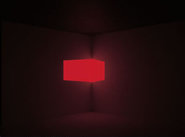James Turrell
dal 12/10/2006 al 27/2/2007
Segnalato da
12/10/2006
James Turrell
Louise T Blouin Institute, London

A life in light
Light is everywhere. Existence is impossible without it. For this reason, perhaps, light appears over and over again as a symbol in the world’s greatest poems, paintings and novels.
Visual artists such as Turrell seem to suggest that light can salvage a soul, can bring us meaning and bear messages that allow us to live with some measure of grace. The paintings of Vermeer are experiments with light - its intimacy, its intensity and its emotional power.
But light is perhaps best understood outside a moral framework - as pure force, as pouring source, as the absolute essence of biological life on this planet called earth, this planet made possible by our singular sun, 93 million miles away from us, our very own mid-life star that radiates out across our solar system, illuminating objects as far away as Pluto, or as near as our hearts and skin.
Light. What is it? It is wave and particle. It is, when parsed, seven sturdy colours from which spring every other hue and tone. It is muscular enough to traverse vast distances, so when you stare into the night sky and see a star up there, you are in fact seeing ancient illumination, a star that may in fact no longer exist - we have no way of knowing. Is the North Star still alive? The light it emits now is in fact from 1812; it takes that many years to reach us. In turn, were an alien civilization to peer down at our sun-saturated globe, it would be seeing a reflection that was thousands, if not millions of years old.
Light. At first there was none. At first all of space was collapsed into a dot smaller than the period at the end of this sentence, so dense that a teaspoon would weigh more than a trillion tons. And then, the big bang, contested for sure, but it is all we have to go on. The primal dot of darkness exploded into the universe, exploded in a roar and rush of light so intense it is beyond the brain to ever even really imagine it. The universe was born in light. We are alive because of light. We can make of light as many symbols and superstitions as we wish, but for what? Light has no need.
Turrell’s work is powerful in part because he knows this; he seeks not to enhance light, but simply to reveal its place in our singular lives, in the history of human kind stretching back to the first flame a human ever found, and then forward, into the cascades of galaxies that suggest, in their distant shimmers, who we may someday become.
It is strange, to me, that we live in a light-filled world on the one hand, and yet in such darkness on the other. Whether the depth of this darkness is unique to our times, or in fact has been the fate of human kind since civilization first appeared, is really a question of little consequence. The question of real consequence is: how can we let light educate us? How can we become en-lightened by light? What can its form, its physics, its existence, impart to us about how to live our lives?
Image: James Turrell, Fastnet, 1992
Louise T Blouin Foundation
3 Olaf Street - London



